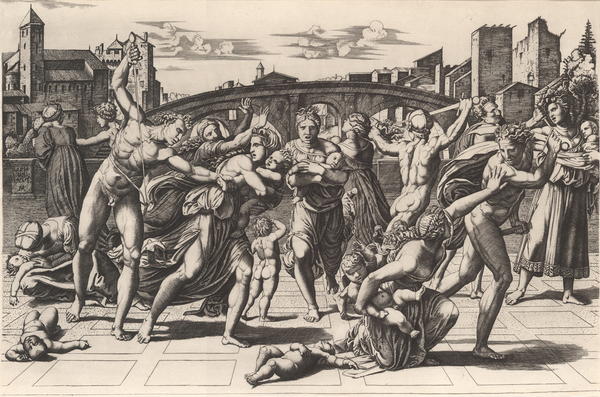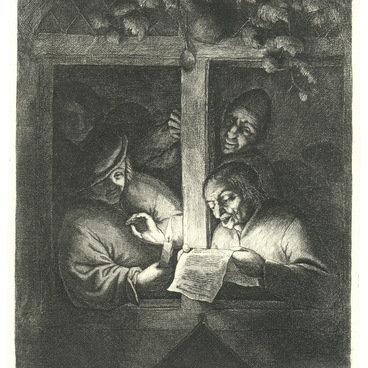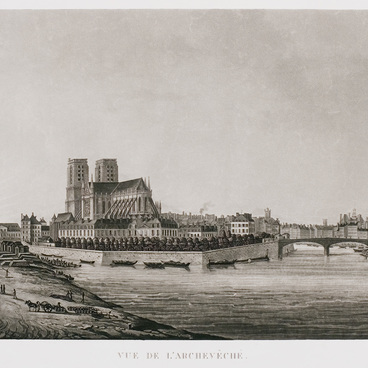Marcantonio Raimondi was an Italian Renaissance engraver. He worked in the then-rare genre of reproductive printmaking and created over 300 interpretations of paintings made by his contemporaries. Raimondi studied painting and niello technique in the workshop of Francesco Francia, but quickly switched over to copper engraving greatly improving it. He roughened copper plates and worked using a graver, a fine steel cutter, one end of which was cut off and sharpened at a 45-degree angle. It enabled Raimondi to create smooth lines and control chiaroscuro volume and contrast.
Massacre of the Innocents
Creation period
15th century
Dimensions
28,5x42,9 cm
Technique
burin, later print
Collection
1
Open in app#3
Marcantonio Raimondi
Massacre of the Innocents
#2
#6
Raimondi made engravings after many artists’ paintings with his copies being almost identical to the originals. Sometimes it led to scandals. In Venice, he bought Albrecht Dürer’s engravings and woodcuts and copied them using his own burin technique. Raimondi even managed to counterfeit the German artist’s monogram. Infuriated with the Bolognese, Dürer filed a complaint against him with the Venetian court demanding that copying be prohibited. The authorities partially satisfied his claims ordering Raimondi to stop using Dürer’s monogram. A couple of decades later, Marcantonio was arrested for publishing a series of erotic prints entitled ‘I Modi’ (‘The Positions’) with a large print run. According to one of the version, he copied Giulio Romano’s drawings privately commissioned to him by the banker Agostino Chigi. All the printed copies of the illustrations were destroyed. Cardinal Medici, sculptor Bandinelli and poet Aretino got Raimondi out of prison, but the engraver’s career and reputation were ruined forever.
#8
In between the two scandals, Raimondi met Rafael Santi. He was the first person to appreciate Marcantonio’s works and distribution potential of his art. Rafael trusted Raimondi with the engraving of his paintings and frescoes, and made modello sketches specially meant for engraving. This practice was quickly adopted universally.
The engraving “Massacre of the Innocents” was created by Raimondi based on Rafael’s studies. According to the Gospel of Matthew, the Magi who came to bow down to the newborn Jesus Christ refused to tell Herod the Great where the baby was. Mad with rage, the king sent his people to kill all baby boys in Bethlehem and the surrounding area, who were two years old or younger. The Massacre of the Innocents described in the Gospel was not a particularly popular subject in early Christian art. The first images and mosaics were restrained and just alluded to the killings. In the paintings by Renaissance artists, there appear soldiers tearing children from women’s arms, the bodies of those killed, dynamics in the movements of those trying to flee. Raphael made a few isolated sketches of individual characters and groups, and Raimondi managed to bring them together into a well-balanced composition. His work with shadows and volumes, the figures’ anatomy and proportions, their gestures and movements impressed his contemporaries.
The engraving “Massacre of the Innocents” was created by Raimondi based on Rafael’s studies. According to the Gospel of Matthew, the Magi who came to bow down to the newborn Jesus Christ refused to tell Herod the Great where the baby was. Mad with rage, the king sent his people to kill all baby boys in Bethlehem and the surrounding area, who were two years old or younger. The Massacre of the Innocents described in the Gospel was not a particularly popular subject in early Christian art. The first images and mosaics were restrained and just alluded to the killings. In the paintings by Renaissance artists, there appear soldiers tearing children from women’s arms, the bodies of those killed, dynamics in the movements of those trying to flee. Raphael made a few isolated sketches of individual characters and groups, and Raimondi managed to bring them together into a well-balanced composition. His work with shadows and volumes, the figures’ anatomy and proportions, their gestures and movements impressed his contemporaries.
#9
Irbit State Museum of Fine Arts (SMFA)
read morehide
00:00
00:00
1x
Massacre of the Innocents
Creation period
15th century
Dimensions
28,5x42,9 cm
Technique
burin, later print
Collection
1
Open in app
Share



